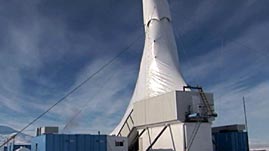Teachers' Domain - Digital Media for the Classroom and Professional Development
User: Preview

Source: ANDRILL



In this video adapted from ANDRILL, a student, a teacher, and a geologist describe a research project in Antarctica designed to answer questions about how our planet has changed over time and predict how it might look in the future. Drilling through an ice sheet and into the sea floor hundreds of meters below, ANDRILL project scientists collect long core samples of sedimentary rock. They then analyze the samples to learn what they can about the environmental conditions that existed when the rock layers were formed.
ANDRILL is an acronym for "Antarctic Geological Drilling." The key aim of the ANDRILL project is to understand how Antarctica's largest ice shelf has responded historically to "climate forcing," or changes in climate brought about by external factors such as volcanism, solar radiation, or the accumulation of greenhouse gases. By taking core samples from rock as deep as 1.2 kilometers (0.75 miles) beneath the seafloor, project scientists can peer up to 5 million years into the past to learn how climate has evolved in Antarctica.
Each layer in a core sample corresponds to a set of conditions. A layer in an ice core, for example, contains most everything that fell along with the snow during a single season, including windblown dust, ash, atmospheric gases, and radioactivity. By studying Antarctic sediment cores from rock below the Ross Ice Shelf, a floating slab of ice about the size of France, ANDRILL scientists can tell such things as when ice sat directly on the sea floor, when the ice shelf was floating over the drilled site much as it is now, and whether and when there was open water with no ice present.
Core analyses done to date suggest that the Ross Ice Shelf has advanced and retreated over time, in perhaps as many as 25 cycles. Variation in grain size is one indicator that sedimentologists associate with advance and retreat. A second indicator is the presence of fossilized, single-celled organisms called diatoms. Diatoms depend on direct sunlight for photosynthesis, so they live near the water's surface. Their presence in parts of the core sample indicates that the ice shelf probably disappeared entirely for periods of time, replaced with warmer, highly productive open waters and, by extension, a warmer overall climate. If predictions of global temperature increases are accurate—with an expected change of 2 to 3°C (3.6 to 5.4°F) by the end of the 21st century—knowing how glacial ice will respond to warming is crucial.
ANDRILL scientists are working to correlate their information with evidence of climate conditions taken from other parts of the world. Besides sediment and rock cores taken from oceans and lakes, other archives of past climate records include ice cores collected in Greenland, which reveal variations in the concentrations of atmospheric gases, and global sea-level records, which can be inferred from sedimentary deposits and erosion surfaces on continental shelves. These multiple lines of evidence can give scientists independent validation of a finding or idea, thereby strengthening their theories.
 Loading Standards
Loading Standards Teachers' Domain is proud to be a Pathways portal to the National Science Digital Library.
Teachers' Domain is proud to be a Pathways portal to the National Science Digital Library.
